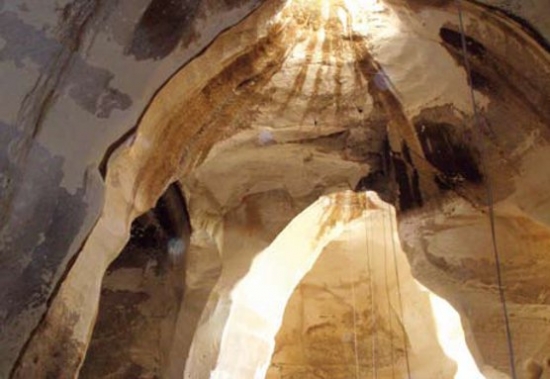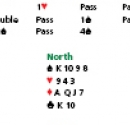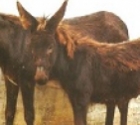
Our guide had promised us spring flowers on our ESRA hike — a profusion of yellow daisies and scarlet anemones among lush winter grasses. Rarer finds were the miniature orchids in delicate pink and an occasional short-stemmed iris in pristine white streaked with gold. Our comfortable walking route that February morning took us to Israel’s southern lowlands, to a section south-east of Ashdod, once the haunts of a warlike, seafaring people — the Philistines. This non-Semitic people had migrated from the Aegean and central Mediterranean, perhaps from Crete or Caphtor as the Bible calls it. They were part of a large migration of sea peoples that began towards the end of the 13th century BCE.
The reasons why the Philistines came to settle along the southern coast of Canaan remain a mystery. Some say that these worshippers of Dagon and Beelzebub fled from their homeland of Crete after a huge explosion of Santorini’s volcano around 1400 BC, followed by a tidal wave. Others speak of earthquakes as the precipitating factor. The Philistines were skilled metal workers, and also fashioned distinctive pottery with red and black geometric patterns on a white background. They were also advanced in agriculture. After Ramses III repulsed their invasion of Egypt, they gradually conquered the Canaanite city states and dwelt in a well organized pentapolis, five fortified towns in the southern region named Ashkelon, Ashdod, Ekron, Gath and Gaza.
We strolled through the Haruvit forest, a JNF recreation site named for its carob trees, and on through rich farmland towards Tel Tsafit, a mound that was once the Philistine city of Gath. This chalky hill is called Tel es-Safi in Arabic; safi, meaning pure, refers to the gleaming white rock that juts out on the gradual ascent to the summit. Because this rock was sought after for building stones by 7th century Muslims, they had hollowed out the small symmetric caves that we passed.
Flocks of black jackdaws, a type of small crow, swooped noisily around the hilltop. Other fauna of the region include the mountain gazelle or Israeli deer, the red fox, the northern jackal, the striped hyena, caracals, badgers and the India crested porcupine. On our walk that day these wild creatures weren’t in evidence — only cows, sheep and goats, though a majestic scarlet beetle scuttled off ahead of me.
On the three kilometer trail to Tel Tsafit, we passed some ancient, sprawling desert tamarisks — massive examples of the Biblical eshel that was planted in Beersheva by our forefather, Abraham. Tel Tsafit controlled a branch of the Via Maris, the historic coastal route that connected ancient Syria and Egypt. Excavations over the last 12-13 years have uncovered eight layers of settlement starting from the early, middle and late Canaanite periods, as well as artifacts from the Israelite, Persian, Roman, Crusader and Muslim periods. At the summit of Tel Tsafit, 213 meters above sea level, are the remains of a Crusader fortress, Blanche Guarde, built in 1142 and destroyed by Salah-A- Din in 1187. Nearby moshavim are Tirosh, Gefen and Sarig, names that are all associated with wine production. There are views of the Judean hills to the east and to the north. Southwards is the Elah valley, containing a pure stream, a favorite with picnickers.
A few kilometers to the south are the Luzit caves, large bell-shaped structures that were hollowed out from the top down. Some were set up as dovecotes to be a source of food and fertilizer and a messenger service. These eco-friendly caves provided their inhabitants with light, air and shade. Luz is an alternate name for the almond trees that are characteristic of the region. On our visit their pink blossoms attracted swarms of honey bees from nearby hives.
This area of coastal lowlands south of Jerusalem is the ideal place to rediscover some dramatic episodes from the books of Samuel and Judges, though other parts of the Bible also refer to the Philistines. Despite an occasional uneasy alliance, the latter engaged in constant skirmishes with the Israelites.
Tel Tsafit, formerly Gath, was the focus of our hike. The site brought to mind the amazing story of David’s uneven duel with Goliath the giant, resplendent in bronze-plated armor, which took place nearby in the Elah valley (1 Samuel, 17). A less familiar Bible story relates how David took temporary refuge in Gath with Achish, son of Gath’s King Maoch, when Saul sought to kill him (1 Samuel, 27). Though David retreated to Gath, accompanied by his wives Ahinoam and Abigail and a motley band of warriors, he soon proceeded to nearby Ziklag seeking more freedom of movement. Though Achish trusted David, requesting his protection in the battle against Saul, this plan was soon thwarted. Achish was voted down by the Philistine princes, who feared David’s reputation.
David’s elegy upon the deaths of Saul and Jonathan includes the plaintive request: “Tell it not in Gath, publish it not in the streets of Ashkelon; in case the daughters of the uncircumcised rejoice.”(2 Samuel 1, 17:27). The epithet uncircumcised was widely applied to the Philistines, and not as a compliment. Gath was destroyed at the end of the 9th century BCE by King Hazael of Aram (2 Kings, 12:18), but later resettled by the people of Judah — only to be destroyed by the Assyrians at the end of the 8th century BCE. Later Gath was among 15 cities fortified by King Rehaboam, owing to its strategic importance.
Ekron, some 11 miles away, formerly the northern border of Philistine territory, comes into the limelight in 1 Samuel, 5:10 and 6:1-8. It was the last place where the Philistines carried the holy Israelite ark before returning it to its native territory seven months later. They realized that they had blundered in capturing the ark when it wrought havoc among them; some commentators blame the bubonic plague. In any event the ark returned to Beth Shemesh laden with propitiatory gifts of gold (five golden emerods and five golden mice, corresponding with the five Philistine rulers), on a new riderless cart pulled by two cows that mysteriously knew the way. Under the Philistines, Ekron, today known as Tel Mikne, became famous for olive oil.
The Philistines were active in wine production too, especially in the area surrounding Ashkelon, then a harbor town. Though Samson’s final revenge against these oppressors took place in Gaza (after his hair was shorn by Delilah and he was blinded and enslaved), earlier in his career he had slaughtered 30 men in Ashkelon. He then delivered their bloodstained garments as a “reward” to the 30 fellows who had solved his riddle about the lion’s carcass and the honey [“Out of the eater came forth food, And out of the strong came forth sweetness,” Judges, 14:14] by threatening his first wife.
The fifth Philistine city, Ashdod, remained the capital of Philistia until it was conquered by King Uziyahu at the beginning of the 8th century BCE, but it went through many conquests afterwards.
Today, tourists — bible-lovers, archeology and history buffs too — can enjoy a visit to these quiet southern lowlands that are within easy reach of the central region. On hot days you can catch a sea breeze in Ashkelon and Ashdod, or on cool days head to the hot springs of Hamei Yoav. Just remember, as you tread the sandy or clay soil, that a turbulent past lies beneath your feet.
 DEAR EDITOR 157 MAGAZINE
DEAR EDITOR 157 MAGAZINE COUNTING ON INFERENCE
COUNTING ON INFERENCE SHULAMIT LAMIE RAVINSKY 1925-2010
SHULAMIT LAMIE RAVINSKY 1925-2010 A new website in English - on Volunteering - Launched in Israel
A new website in English - on Volunteering - Launched in Israel Help Needed for Abused Horses and Donkeys
Help Needed for Abused Horses and Donkeys Heather's Heseg
Heather's Heseg Susan de la Fuente
Susan de la Fuente